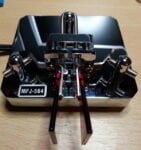MFJ Iambic Paddle
 Within my station is an MFJ 564 paddle which is used for sending morse code, or CW as it’s also known.
Within my station is an MFJ 564 paddle which is used for sending morse code, or CW as it’s also known.
Yes, even though morse code is one of the oldest methods of radio communication, it is still very widely used and popular with operators who prefer to use as little power as possible (QRP) to maintain a contact.
Some amateur operators prefer to use the original style of morse key (straight key) which is the type often portrayed on TV and film as used by telegraph operators in westerns etc. A lot of the old “keys” can be quite collectable which makes them valuable.
The paddle differs in that they are best described as two keys mounted back to back horizontally. The major difference being that one (often the left) is used to produce the “dots” (dit) and the other to produce the “dashes” (dah).
When both contacts are closed simultaneously by squeezing the paddles together, the ‘iambic’ function (alternating dits and dahs) are created with an electronic keyer. The keyers are now normally built into the transceiver but external keyers for radios without the built-in keyer are available.
The paddle type keys are often referred to as iambic paddles, however, they are more accurately described as dual lever paddles as it is the electronic keyer that produces the iambic keying.
Iambic keying or squeeze keying creates alternating dits and dahs. This makes sending some characters easier, like the letter C, by merely squeezing the two paddles together.
In single-paddle/key, non-iambic keying, the hand motion would require alternating four times for C (dah-dit-dah-dit). Download a copy of the international morse code here